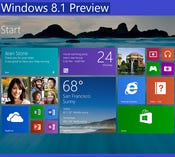Microsoft Reorganization Signals Big Challenges AheadMicrosoft Reorganization Signals Big Challenges Ahead
Microsoft CEO Steve Ballmer now has the pieces in place, but will renaming divisions and shuffling executives bring a legitimate payoff?


10 Hidden Benefits of Windows 8.1
10 Hidden Benefits of Windows 8.1 (click image for larger view)
As expected, on Thursday Microsoft CEO Steve Ballmer announced a company-wide reorganization. Foreshadowed as far back as last fall, when Ballmer said Microsoft would become a "devices and services" company, the move is intended to make the company more cohesive and collaborative -- an important prerequisite to the connected universe Ballmer envisions, in which online experiences will translate across discrete Windows devices via the cloud.
Under the new structure, Microsoft, which employs nearly 100,000 people, will distribute activities across four divisions -- half as many as now. Given the size and scale of Microsoft's operations, it was no doubt a huge undertaking to realign the company's talents to fit its evolving goals. Nevertheless, renaming divisions and shuffling executives will likely seem simple compared to what comes next -- making the new strategy pay off.
Observers on Wall Street and throughout the IT world will be watching closely for signs of progress. Microsoft's stock price has been on the rise in recent months, propelled by strong earnings in the face of the PC market's worst downturn in history. Even so, CEO Steve Ballmer remains under pressure, as the meteoric progress of cloud-oriented businesses such as Windows Azure and Office 365 has not distracted from Windows 8's mixed reception and poor progress.
The full effect of the reorg won't play out for months, but Ballmer will face a stiff test over the next nine months; the company hopes that Windows 8.1 will jumpstart device sales over the holidays and tempt enterprise users as businesses move off of Windows XP, which remains popular but will lose support in April.
[ Looks like Microsoft is finally seeing the light. See Microsoft Understands Its Windows 8 Mistakes, Finally. ]
Julie Larson-Green, who had overseen Windows, will lead a new devices and studio group whose purview will include Xbox hardware, the Surface line of tablets, hardware accessories and games.
Operating systems, including the Xbox, will be consolidated under Terry Myerson, who previously oversaw engineering for Windows Phone.
Qi Lu, who had led Bing, will take over a new applications group and manage the company's Office and Skype businesses
Satya Nadella, who had been running Windows Azure, will head a new cloud and enterprise group.
Aside from the four divisions noted above, Ballmer has also expanded the role of Tony Bates, the former president of Skype. He will lead mergers and acquisitions, business development and relations with developers. Kurt DelBene, who ran the Office division, is retiring.
Some product groups will continue to operate relatively unchanged at the local level, but with new managers and cross-divisional cooperation added to the mix. Kirill Tatarinov will continue to run Microsoft Dynamics, for example, but will report to Qi Lu for product development, Tami Reller for marketing, and to the COO group, which will continue to be led by Kevin Turner, for sales.
"As the times change, so must our company," Ballmer wrote in a memo to employees that introduced the changes. Rumors of the shakeup had grown louder in recent weeks. The CEO reportedly confined reorg planning to a small group of close associates, a decision that allegedly left some excluded execs uncertain about their futures.
The anxiety of Microsoft employees aside, the new organizational hierarchy appears well-positioned to address at least some of the old system's flaws. In an email interview prior to the announcement, for example, Forrester analyst David Johnson said the company's silos operated under independent sets of goals and metrics. The setup isolated units from one another, and sometimes resulted in one division impeding the progress of another. Under the reorg, finance and marketing functions will now be centralized, rather than spread across numerous semi-autonomous units. This shift could encourage Microsoft leaders to collaborate more effectively, and perhaps to realize the promise of Steve Ballmer's vision.
In his memo, the CEO framed that vision around a speech he gave several years ago at CES, the annual consumer electronics extravaganza in Las Vegas.
"I observed there was a shift underway," he wrote. "We were headed from a phone, a PC and a TV to simply three screens and a cloud -- and over time, a common software-based intelligence would drive all of these devices, bringing them together into one experience for the consumer."
Ballmer's critics might view this as revisionist history; by rooting his goals so far in the past, Ballmer suggests the company has been moving deliberately toward the future, a perspective that neglects the widely held view that Microsoft underappreciated the importance of mobile devices. Some of Windows 8's struggles can be attributed to its unfamiliar Modern UI, but adoption has also been slow because Microsoft accorded Apple's iOS and Google's Android such a large head start in the tablet market.
Even so, Ballmer's point remains: Thanks in part to the cloud, multi-device workflows are becoming more popular, and device categories, such as laptop verses tablet, are dissolving. In an interview prior to the announcement, Gartner analyst Carolina Milanesi said that with Azure, SkyDrive, Office 365, Windows 8 and other assets, Microsoft has the pieces to capitalize on these emerging trends. The problem, she stated, is that the company has "ingredients" but has not yet blended them into a "recipe."
Indeed, one of the factors by which Ballmer's plan will be measured is the extent to which cohesion across the Windows ecosystem improves. The CEO explicitly stated in his memo that this will require a consumer emphasis, but he also underscored that designing for "enterprise needs" will remain a core value.
About the Author
You May Also Like






